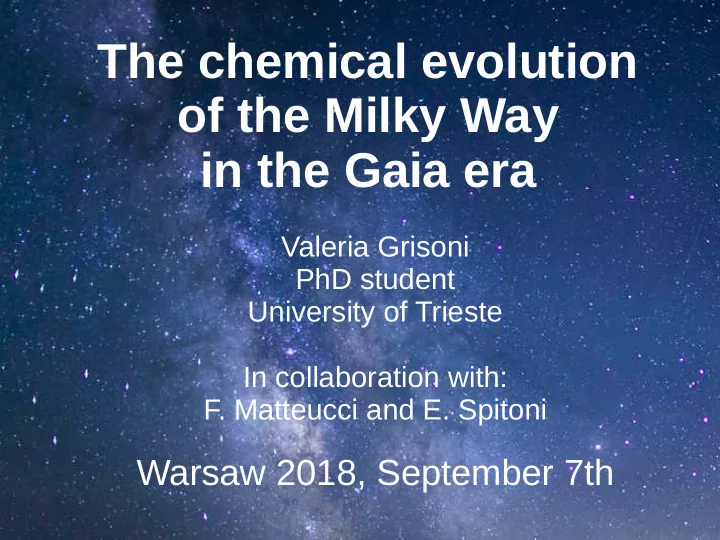

The chemical evolution of the Milky Way in the Gaia era Valeria Grisoni PhD student University of Trieste In collaboration with: F. Matteucci and E. Spitoni Warsaw 2018, September 7th
Observational data AMBRE data (Mikolaitis et al. 2017) show that in the abundance patterns of the α-elements there are two distinct sequences corresponding to thick and thin disc stars, and also a further metal-rich high-α MRHA population. THICK MRHA THIN Observed [Mg/Fe] vs. [Fe/H] from Mikolaitis et al. (2017), where 2
Basic ingredients of chemical evolution models ● Initial conditions ● Gas flows ● The stellar birthrate function: SFRxIMF ● The stellar yields 3
Basic equations 4
Chemical evolution models In Grisoni et al. (2017; 2018), we model the thick and thin disc evolution by adopting two different chemical evolution approaches: i) a revisited two-infall approach (Chiappini et al. 1997; Romano et al. 2010) applied to the thick and thin discs; ii) a new parallel approach, where thin and thick discs start forming at the same time. Basic parameters: timescales of the formation and star formation efficiencies in the two discs. 5
Results of Grisoni et al. (2017): i) star formation history Two-infall Parallel Thick Thick disc disc Thin disc Thin disc Gap Temporal evolution of the star formation rate for the two-infall model (left) and the parallel model (right). 6
ii) abundance patterns Two-infall Thick disc Gap Thin disc Parallel Thick disc Thin disc Observed and predicted [Mg/Fe] vs. [Fe/H] for the two-infall model (upper panel) and the parallel model (lower panel). 7
The only way to interpret the MRHA stars in terms of the two-infall model is by assuming radial migration, i.e. stars moving from other Galactocentric radii. Observed and predicted [Mg/Fe] vs. [Fe/H] for the two-infall model at various Galactocentric radii (inside-out scenario). 8
iii) metallicity distribution function N/Ntot THIN THICK MRHA N/Ntot [Fe/H] [Fe/H] THICK+MRHA N/Ntot THIN N/Ntot [Fe/H] [Fe/H] MDFs observed and predicted by the two-infall model (upper panels) and by the parallel model (lower panels). 9
Results of Grisoni et al. (2018) [Mg/Fe] [Fe/H] [Mg/Fe] vs [Fe/H] at various Galactocentric distances observed by APOGEE (Hayden et al. 2015) and predicted by the models of 10 Grisoni et al. (2018).
Results of Spitoni et al. (2018) Upper panel : [α/Fe] vs [Fe/H] predicted by the parallel model (Spitoni et al. 2018) compared with APOKASC data by Silva Aguirre et al. (2018). Middle panel: [α/Fe] vs age predicted by parallel model and compared with APOKASC data. Lower panel: parallel model results, in which the observational errors have been taken into account. 11
Results of Spitoni et al. (2018) Upper panel : [α/Fe] vs [Fe/H] predicted by the two-infall model (Spitoni et al. 2018) compared with APOKASC data by Silva Aguirre et al. (2018). Middle panel: [α/Fe] vs age predicted by the two-infall model and compared with APOKASC data. Lower panel: two-infall model results, in which the observational errors have been taken into account. 12
Results of Spitoni et al. (2018) [α/Fe] vs [Fe/H] at different age ranges, observed by Silva Aguirre et al. (2018) and predicted by the two- infall model taking into account the observational errors on age and metallicity by Spitoni et al. (2018). 13
Summary and conclusions In Grisoni et al (2017; 2018) we studied the formation and evolution of the Milky Way thick and thin discs and compared our results with recent data (AMBRE and APOGEE). We adopted two different approaches: i) a two-infall approach applied to thick and thin discs. This approach seems the best to reproduce the abundance patterns as well as the ages of stars. The metal-rich alpha- enhanced stars, in this framework, can be interpreted as stars migrated from the inner regions; ii) a parallel approach. While this approach could explain the metal rich alpha-enhanced stars, it seems less suitable for reproducing the stellar ages, as provided by asteroseismology (Spitoni et al. 2018). 14
Recommend
More recommend